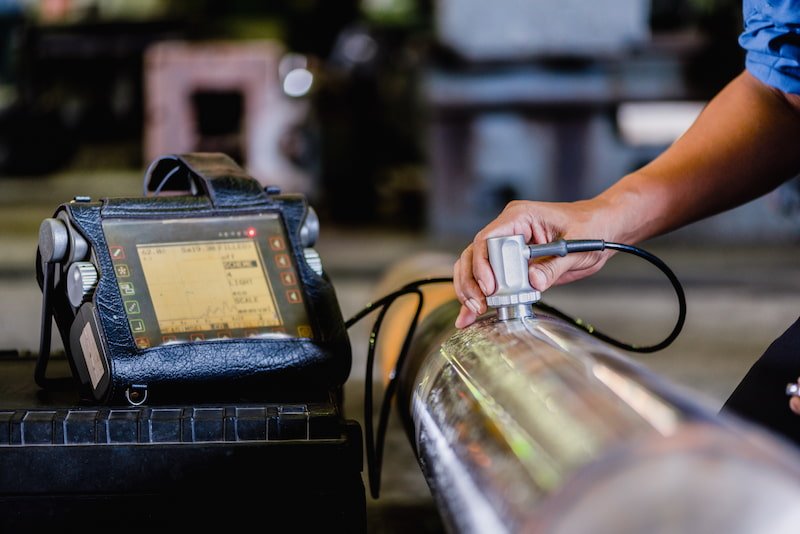Ultrasonic Testing
- Ultrasonic Testing (UT) uses high frequency sound energy to conduct examinations and make measurements. Ultrasonic inspection can be used for flaw detection/evaluation, dimensional measurements, material characterization, and more. Ultrasonic testing is carried out using an ultrasonic flaw detector and an ultrasonic probe. In the inspection, ultrasound is sent into the area of interest by straight beam or angular beams.
- The ultrasound can be reflected from an interface (ex. Discontinuity) and received by the probe. The reflected ultrasound is displayed on a cathode ray tube screen in the flaw detector and the signal can be analyzed. This method is good for detecting internal discontinuities. Ultrasonic can be done on all type of materials and forms like casting, welding , forging, rolled products and composite.


- The advantages of Ultrasonic Testing is it provides instantaneous result, Equipment can be highly portable or high automated, Nonhazardous, Highly accurate, minimum part preparation is required and low cost.We have a team of qualified and experienced Engineers. We provide high quality services for various industries like Casting, Forging, Fabrication, Piping, Boilers, Power plant and Refineries. We are equipped with advance and computer controlled equipments for service.
Ultrasonic testing objects and thickness ranges
Ultrasonic testing is appropriate for inspecting raw materials and components of pressure equipment, including butt welds, T-welds, fillet welds, and surfacing layers of pressure equipment. Examples of these materials include plates, composite plates, carbon steel and low alloy steel forgings, pipes, bars, solid stainless steel forgings, etc.
| Ultrasonic testing object | Thickness range, mm |
| Carbon steel, low alloy steel, nickel and nickel-based alloy plates | Base metal is 6~250. |
| Aluminum and aluminum alloy plates, titanium and titanium alloy plates | Thickness is ≥ 6. |
| Carbon steel, low alloy steel forgings | Thickness is ≤ 1000. |
| Stainless steel titanium and titanium alloy, aluminum and aluminum alloy, nickel and nickel alloy composite plate | The thickness of the substrate is ≥ 6. |
| Carbon steel, low alloy steel seamless steel pipe | The outer diameter is 12~660, and the wall thickness is ≥ 2. |
| Austenitic stainless steel seamless steel pipe | The outer diameter is 12~400, and the wall thickness is 2~35. |
| Carbon steel, low alloy steel bolt parts | Diameter is >M36. |
| Full penetration fusion welding steel butt weld | The thickness of the base metal is 6~400. |
| Butt welds of aluminium and aluminium alloy pressure vessels | The thickness of the base metal is ≥ 8. |
| Butt welds of pressure vessels made of titanium and titanium alloys | The thickness of the base metal is ≥ 8. |
| Circumferential weld of carbon steel and low alloy steel pressure pipe | The wall thickness is ≥ 4.0, the outer diameter is 32~159, or the wall thickness is 4.0~6, and the outer diameter is ≥ 159. |
| Circumferential weld of aluminum and aluminum alloy pipe | The wall thickness is ≥ 5, the outer diameter is 80 ~159, or the wall thickness is 5.0~8, and the outer diameter is ≥ 159. |
| Austenitic stainless steel butt weld | The thickness of base metal is 10~50. |
